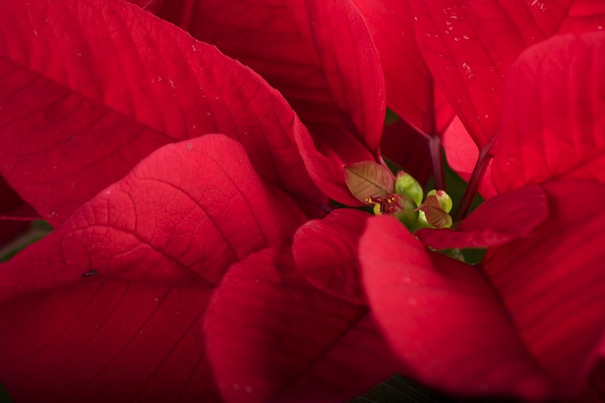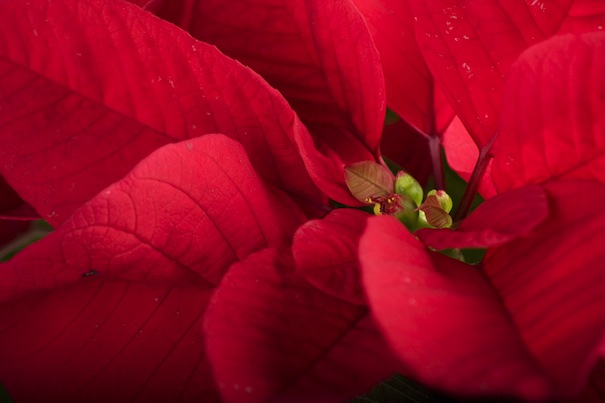Make your winter a time of colour… and think ahead to the new year’s gardening.
Poinsettias bring living colour to winter
One of the brightest Christmas plants is the poinsettia. With its bracts of red, pink or cream, it brings instant colour to a room. The range is steadily expanding – this year we’ll have a new variety called ‘Glitter’ which is a deep pink with cream markings, plus English grown miniature poinsettias, which are around 10-15cm tall and ideal as a gift.
English grown are best, and always buy from a reputable supplier. If they get a draught from standing in doorways or on outdoor markets, they suffer. They like good light during the day and a warm room at all times. Only water when the soil is dry and never stand in water for longer than 10 minutes.
Staying on track over winter
We can think of winter as a barren time, but it doesn’t have to be. As well as poinsettias (see left/right/above), other plants ideal for Christmas colour are Christmas cherry with its shiny red-orange berries; Christmas cacti, which produce beautiful red, orange, white or lavender flowers; easy-care cyclamen, which make popular gifts; azaleas, which flourish in either a warm or cool room; and phalaenopsis orchids, which last for months and will sit happily in a warm living room.
Water houseplants less than you would during the summer, and stop feeding. Always empty water from saucers after approximately 15 minutes. Most plants with showy flowers and fruits need bright light, so do not display them in a dark location. Avoid draughts and locations where temperatures are likely to fluctuate. If plants are very close to windows, move at night to prevent chilling.
Christmas trees
From November, fresh Christmas trees are available. The most common types are Nordman firs (abies nordmanniana), and Norway spruce (picea abies).
When you get your cut tree home, leave it outside for as long as possible. Once inside, stand a saucer underneath the pot so that you can water it regularly. Try not to keep the tree indoors for more than 14 days. Keep the base moist as the warm temperature and dry air will make the tree absorb water quickly. Reduce loss of moisture to a minimum by positioning away from sources of heat such as radiators, fires and TV sets.
Rooted trees are becoming more popular; they can be planted outside after Christmas and have a good chance of growing on for future years. After Christmas, take the tree outside and stand against the warmest side of the house for a day or so to help the tree adjust to outdoor temperatures. Water if we get a mild spell, and hopefully you will see new shoots appear on your tree in spring.
Protect your plants as it chills
If you haven’t already done so, prepare fleece to put over tender plants such as phormiums, cordylines, hebe and tree ferns once the frosts arrive. Cut back the stems of herbaceous perennials that have finished for the year – phlox, lupins, delphiniums. Reduce stem lengths on roses to prevent them loosening in the wind. Borders can be tidied and mulched with compost, well-rotted manure or bark.
Planting now for later
As long as there’s no frost in the ground, now is an ideal time to plant bare root hedging and fruit trees. By buying new season roses now, you get the best range of varieties and the plants have chance to settle into the ground before the weather gets too bad.
Autumn and winter maintenance
Continue to clean up leaves as they fall from trees, particularly where they may fall into fish ponds. If we get some snow and ice and you have a pool, try putting a ball onto the surface so that you can keep an area free of ice, allowing the air to circulate. Pool heaters are a good idea for cold winters and the fish congregate by the warmth!
Check heaters in glasshouses to ensure they work when needed. If we do get a cold spell, open the doors on greenhouses occasionally to allow fresh air in; this is especially important with paraffin heaters, where fumes build up and you can soon lose plants you’re over-wintering. Drain down hosepipes and water features that won’t be used again until next spring to prevent frost damage.
Don’t forget the birds – feed daily with seed, not bread, and remember that once it freezes, birds still need a supply of fresh water.
Once the weather gets too cold and frosty to get into the garden, it’s time to dig out the seed catalogues for 2014 and start planning for a new season.
Merry Christmas and a happy and healthy 2014 to you all.
This month’s tips are provided by Ann Winwood of Lealans Garden Centre, Shipley.







